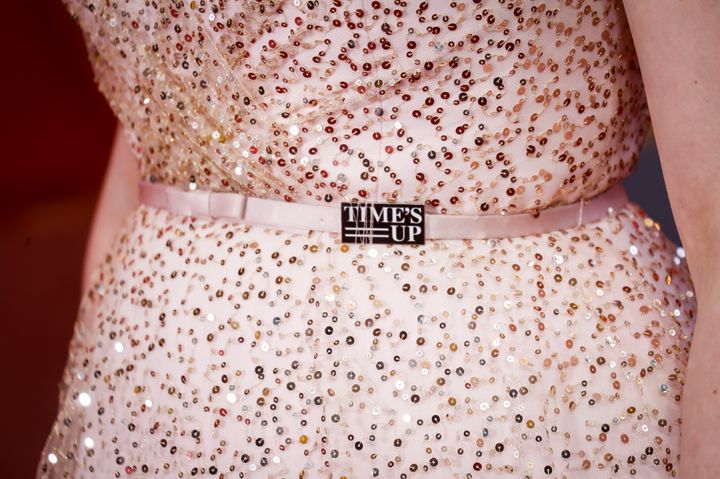
If ‘female empowerment’ is the new black in the fashion industry – in every industry – then the lipstick effect of fashion, and feel-good items such as lingerie and hosiery in particular, seems to be the signage. Of course, we’ve always known that fashion is a symbolic mood-enhancer, but the climate right now of the post-Weinstein, Time is Up and Me Too collective consciousness - in the year we celebrate 100 Years of women securing the vote – is really apparent.
Mintel predicts that the UK lingerie market will increase by 11.4% between 2016 and 2012 to top £3bn, in what might be an example of cash-squeezed shoppers opting for items with lower price-points with an inversely high dopamine hit, rather than ‘burning their bras’! Meanwhile, the discussion of what constitutes empowering clothing – the clichéd ‘power dressing’ – has become a mainstream and heated one. From actors wearing black for the awards season to the outlawing of the Formula 1 ‘grid girls’, the argument around how what a woman wears affects how she feels and how she is perceived has never seemed so vocal. Actually, it’s a historical discourse and not new at all, but presumptions are being challenged and, typical of the fashion industry, views are being expressed and so-called ‘rules’ broken.
In a recent interview for the March edition of Vogue, Miuccia Prada, talks of challenging the dismissal of fashion as ephemeral nonsense: “A clever woman can also be super-sexy, super naked, she can be whatever she wants. […] I don’t think there is a look for a militant woman”, she tells Claudia Croft . At the same time, the perception of fashion stylists – and A-list frock brokers - as frivolous is also being debunked, with male celebrities such as Tom Hiddleston even declaring his stylist to be “one of the best things to happen to me”, while Paloma Faith asserts that “dressing up is like therapy.” She maintains, “I feel better in myself when I’ve made an effort”.
As society starts to appreciate the holistic benefits of fashion, the service of a stylist is gaining popularity outside of celebrity circles too, as they inadvertently venture into the role of life-coach and quasi-style therapist.
As a personal stylist, this is what Fleur McCrone – a London-based mother of 3, tries to instil her in clients: “Time and time again my clients tell me how much their self-esteem and confidence has been boosted from wearing clothes that suit them. I believe that discovering and developing your own personal style can give you the courage to be seen and empower you to be the best version of yourself. […] It’s a very therapeutic process which can be incredibly moving to provide”, says Fleur, who started her business ‘Fine Styling’ just over a year ago.
Fashion and Feminism
I’ve been astonished – but mostly fascinated - by some of the statements made and conflicting views on the subject. Especially regarding how much a woman’s clothing ‘should’ reveal or whether the cause for equality is strengthened by women adopting less feminine traits. Namely, is dressing ‘sexy’ sexist or empowering; and does embracing femininity contradict a woman’s demand for respect and equality? Should a feminist adapt to masculine dress or celebrate femininity as in the view espoused by Dita Von Teese; ‘It’s not about seducing men; it’s about embracing womanhood?’
Like any term which gains popularity, female empowerment can result in a tsunami of eye-rolling and a chorus of sotto voce sighs, and yet the core point really seems to come back to freedom, fashion and femininity and their interplay.
Fashion, feminism and politics has always been heated territory, and even the suffragettes knew this. Instead of deploying a strategy of resistance by refusal, they chose resistance through reversal. They sought to effect change not by challenging contemporary fashion and ideals of femininity, but by conforming to them. Haunted by the stereotypical image of the “strong-minded woman” in masculine clothes, pebble-thick glasses and galoshes created by cartoonists, they chose instead to present a fashionable, feminine image. The suffragettes’ colour scheme was an early triumph for fashion branding. Suffragettes wore purple for loyalty and dignity, white for purity, and green for hope.
Importantly in this whole debate, the suffragettes took care to “appeal to the eye” – particularly when in full glare of media attention on parade or demonstrating. In 1908, one of their newspapers, Votes for Women, declared: “The suffragette of today is dainty and precise in her dress.” Miuccia Prada makes this point today too, urging cultural feminist intellectuals to ask “How to be more appealing. Culture should be attractive, otherwise no-one listens”.
While women have spent decades, if not centuries, batting away the narrow definition of what is expected of them, the clothes they wore helped make their intentions known. What causes society to panic isn’t different hemlines, but rather women defining for themselves what it means to be a woman. So, the power of dress was an important tool that influenced their standing in society, helping them towards less oppressive gender norms with every snap, zip, and fasten and paving the way for today’s mood.
Back to Ms Teese. I’ve always believed that one of the reasons why fashion occupies such a special place in our culture is precisely because of the way it makes us feel. In the words of Rachel Zoe, “Style is a way to say who you are without having to speak” and thus it has immense power. The power to empower.
To use the words of the scion of the Prada dynasty, “It’s important that we don’t lose our femininity; that we find a way to do what men do, but in a woman’s way”. I couldn’t agree more. Embrace who we are and whatever our style.
